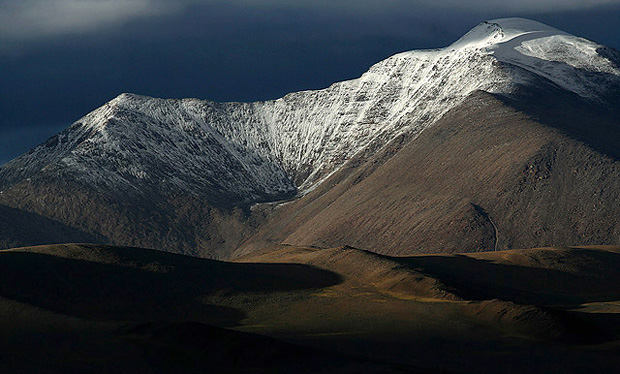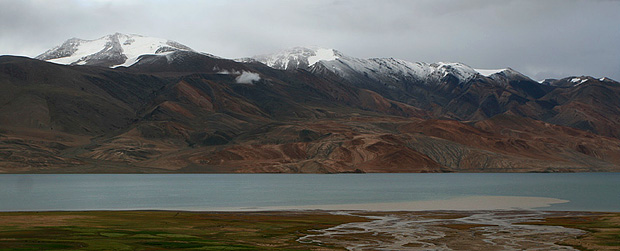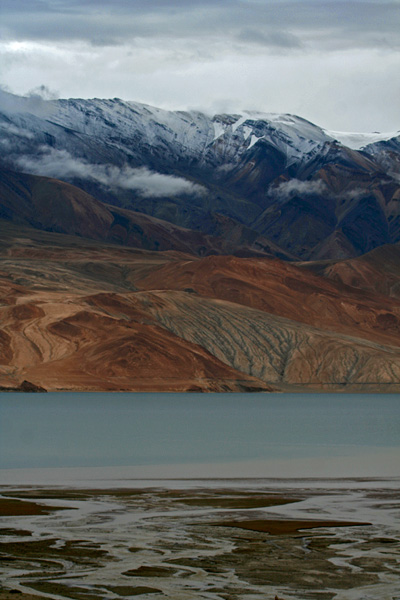On the morning of July 4th, there was a visible excitement outside Korzok Monastery. People moved back forth in anticipation of an exciting day. The place was full of people who had come from pastures located near the village. Women moved around in excitement, wearing best of their traditional attire and jewelry and excitedly talking to old friends whom they were meeting after a long time. The lamas walked back and forth or worked on the last touches for the festival day. Some were getting the costumes out, some were preparing the masks and a few were taking out the musical instruments. It promised to be an exciting day.
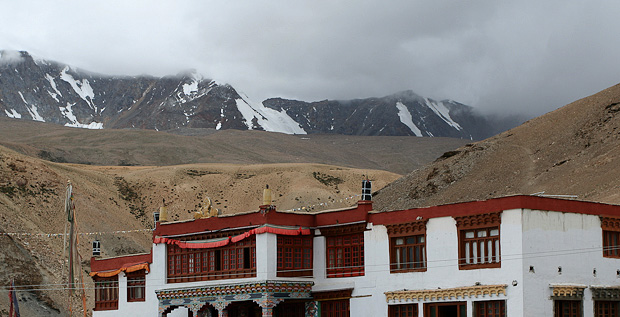
Korzok Monastery and the mountain slopes of changthang
It was the day of Korzok Gustor Festival at the most popular monastery in Changthang region. The monastery’s affiliation was not limited to Korzok Village alone but extended to many changspa nomadic groups who wandered the plateau looking for grasslands to feed their animals. It was a day when most of these nomads would come together to witness the celebrations.
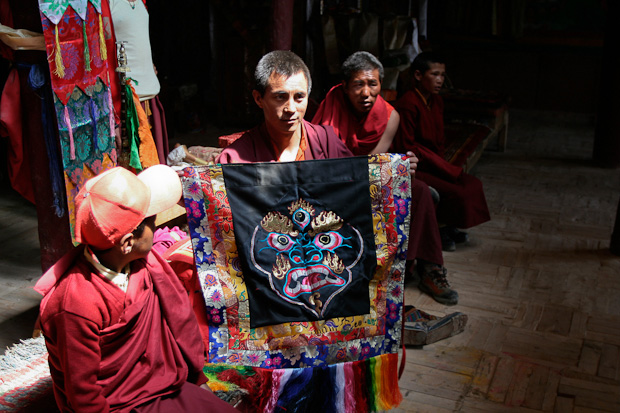
Getting ready..
The festival perhaps begins early in the morning as lamas perform long rituals in the prayer hall. I had been hoping to catch these rituals but despite asking many people including a few lamas, it seemed impossible to get the schedule of activities during the two-day festival. I would get a different answer each time I asked someone, and worse, I would get different answers when we asked the same person second time. What was left for us was to hang out at the monastery the whole day and hope not to miss anything.
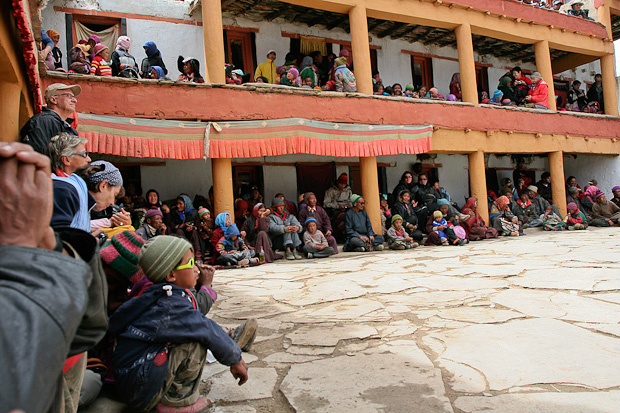
watching the performance
We did miss the prayers but not the cham-dances, the most attended and perhaps the most important part of the two day festival. The whole village and the nomad population squeezes itself to the tennis-court sized courtyard to watch the lamas dance. In the past decade or so, addition of an equal number of tourists coming in to witness the show meant you had to arrive really early to look for a good place to watch the happenings without any obstructions.
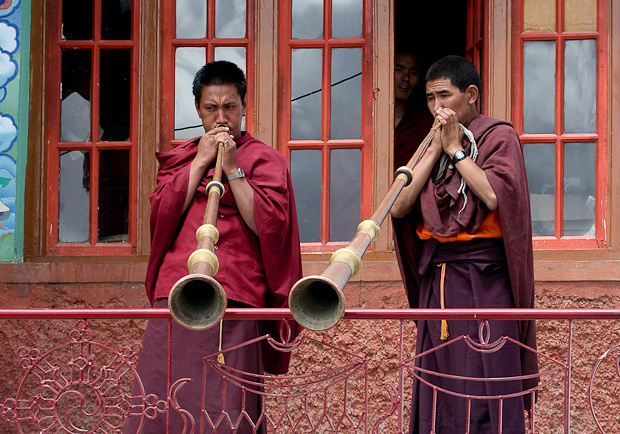
Dung chen, the long trumpets
The festival began with a sudden eruption of sound from dung-chens (very long trumpets) as the head lama walked into the courtyard and conducted a short ritual. Lamas came out one after the other and performed the slow cham-dances synchronized to the sound of drilbu (bells) and nga (drums).
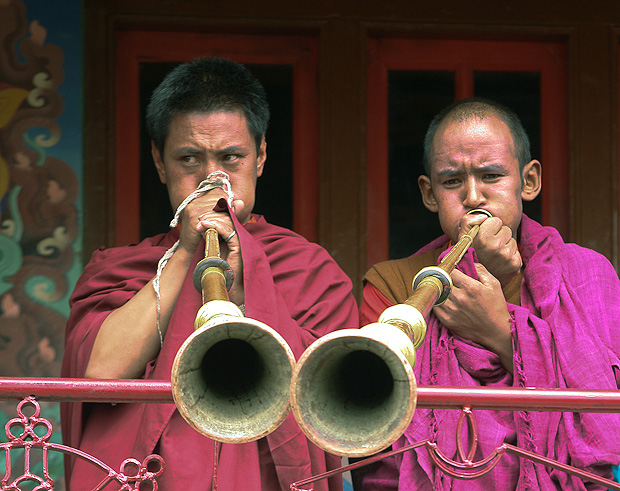
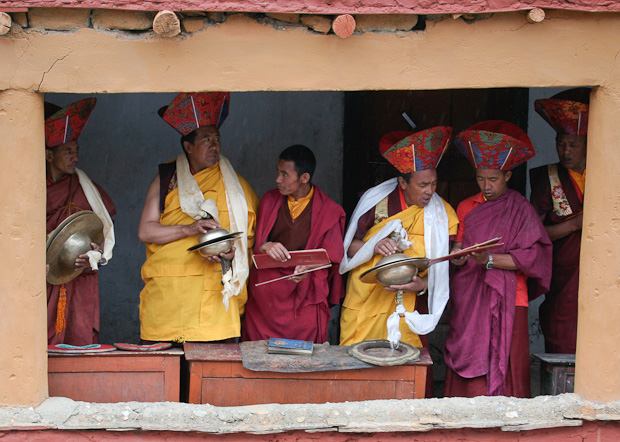
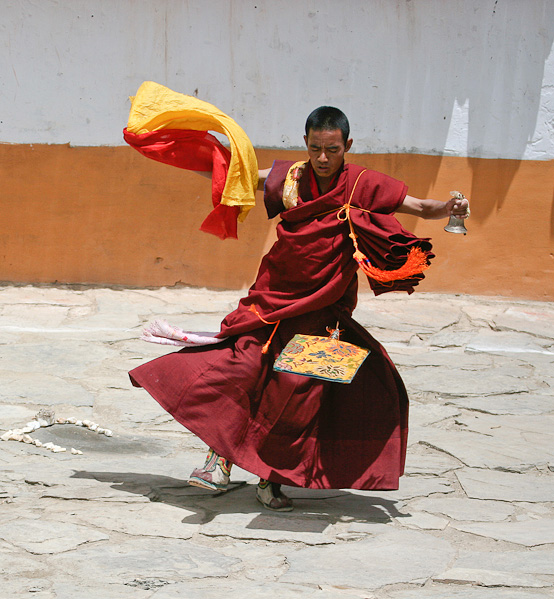
cham dance performance
On the second day, the celebration began by bringing in a few animals to the monastery. The pack included two horses and several goats, later joined by a well fed yak that instantly gained my respect, thanks to its size. It was time to worship these animals that had worked hard through the year to help the Ladahis make their living. The animals were cheered by changspa men as well as the lamas. Lamas applied butter on their forehead and threw a maroon paste on their body. This is a land where perhaps everything is sacred, not just animals but even beer. So it was time to shake a beer bottle and sprinkle on the animals. Shaken by the cold and scared by the noise, the horses got jumpy and the goats were shivering. The horses tried to run and then started fighting between each other, but the lamas quickly herded them out of the monastery and ended their agony. However, no one tried to mess up with the lone giant yak later; it had a size the automatically gets everyone’s obeisance.
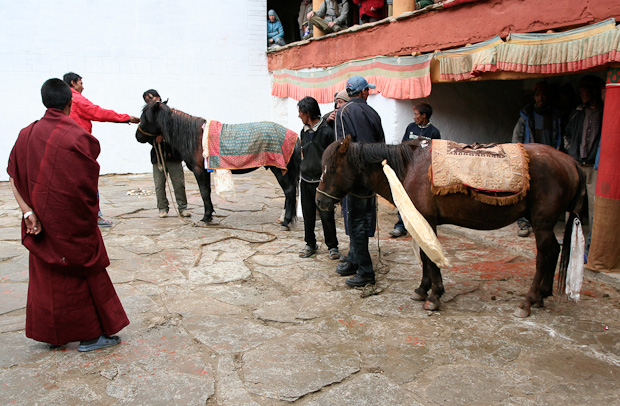
It was time for the cham-dances. The monks danced without the masks on the first day and repeated the performance wearing masks on day two. The masks came in various shapes – of demons, of strange creatures like cows with canines and of forms that can beat anyone’s imagination. The dances began slow and easy as the monks took deliberate steps circling around the flagpole at the center of the courtyard. The pace improved slowly with the progress in the dance and concluded with sudden and swift moves that were more suitable to the wild demon-like cover on their faces.
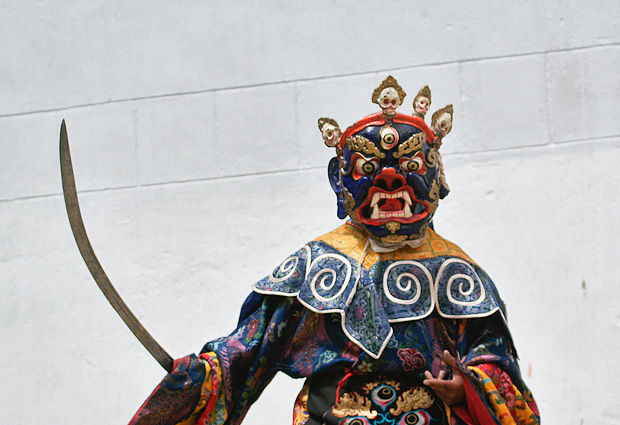
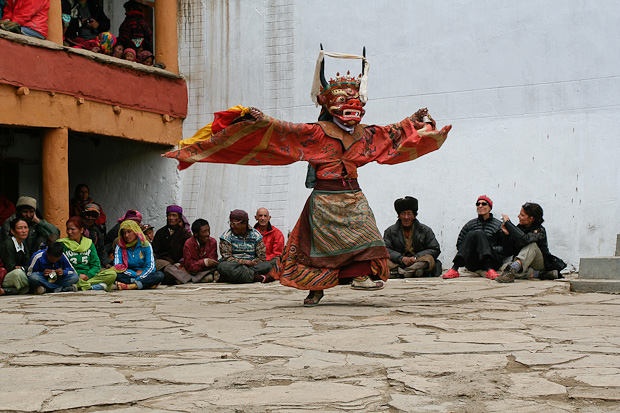
cham dance performance
While all this serious work with calculated beats and synchronized steps went on at the center of the courtyard, there was a masked man walking around with a whip scaring children and anyone who was likely to get scared. Some people laughed at him and pushed him away while he managed to push a few himself. He went to a corner full or tourists, showed the whip, shook his head and demanded them to part with money. A few obliged with small bills and others let out a nervous laughter. He tried the same with a Ladakhi girl later and got beaten up by her in response. These people of Ladakh never take anything seriously, not even the religious rituals. At the same time, Ladakhis are deeply religious and Buddhism defines a great deal of their everyday life.
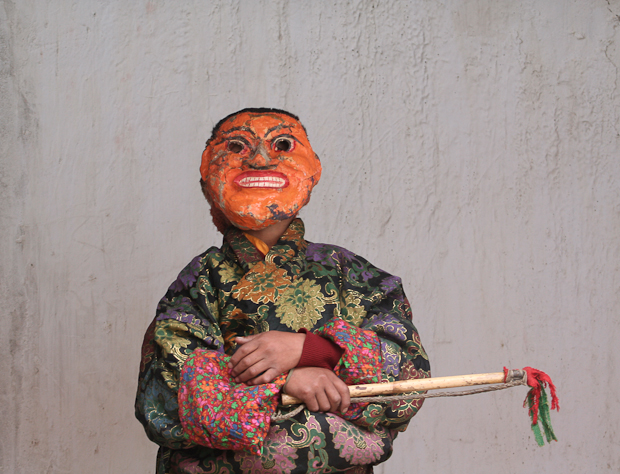
That evening, we were walking on the lake shore enjoying the quiet, cloudy evening, watching small waves hit the grassy shoreline. Tso Moriri’s shore is among the most beautiful places I have seen in Ladakh. To one side of me was a vast blue lake flanked by tall peaks with just a little bit of snow dotting their tips. On this side of the lake was a green stretch of grassland, a spectacle rarely seen in the barren landscape of Ladakh. The scale and grandeur of the lake and mountains seemed to have an ability calm the mind and instill peace, letting the million things that haunt in the head disappear for a moment.
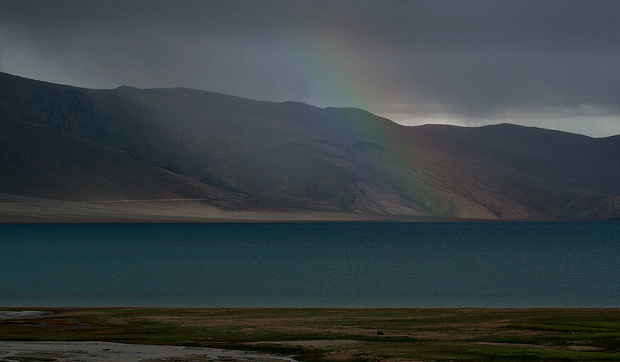
Tso Moriri Lake
As we walked slowly along the shore letting the cool breeze of the cloudy day caress us, I heard some voices coming from the village. A small procession had begun from the monastery, with a lama holding a fire leading the way and the entire village walking behind him. We joined them quickly as they gathered just outside the village. A mask—the kind that is used during the cham dances—was put on fire as the villagers stood in a circle and watched the smoke go up. It marked the end of the festival, symbolizing burning of all evil that had accumulated in the past one year.
Prints of all the images available. Request for prints.
A version of this article and images appeared in August issue of Terrascape, a travel magazine for whom I am an editorial consultant.
As the first rays of sun fell on the tip of icy mountain peaks of Ladakh, the atmosphere reverberated with sounds of ‘Om Mani Padme hum.’ About a hundred monks gathered for early morning prayers in Leh’s Soma Monastery and chanted mysterious-sounding hymns for the next two hours. As I watched sitting in a corner of the prayer hall, young monks with boyish grin on their face ran back and forth, serving butter tea to pious monks as well as to the curious tourists.

A cham dance performance during a monastery festival at Korzok Village near Tso Moriri Lake
In the remote mountain region of Ladakh where the terrain is harsh and the weather is so hostile that it remains inaccessible for eight months a year, a hospitable community practices a form of Buddhism that has remained unaltered for almost a millennium. Resident monks who practice and worship in the monasteries spread across Ladakh ensure perpetuation of this ancient culture in its original form.
The ochre-robed monks performed this morning ritual in the richly decorated prayer halls of every monastery across Ladakh. Travelling through the villages and towns of Ladakh, I went from monastery to monastery witnessing a similar scene in the morning hours. These places of worship are the last resorts of Buddhism in India that have retained the flavour of a religion that is a mix of original Buddhist preaching and the Tibetan animist practices.
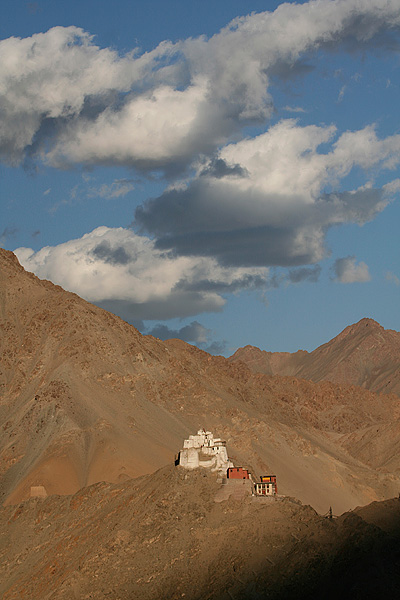
Namgyal Tsemo Monastery, Leh
Ladakh is a sparsely populated area high up in the Indian Himalayan terrain bordering the Tibetan Plateau. Its hostile geography has an average altitude above 10,000 feet, where annual rainfall is negligible and nothing grows on the mountain slopes. This mountain landscape with its tall snowy peaks, streams running down from snow melt and narrow river valleys amidst the arid landscape, is home to a Buddhist population that is perhaps among the happiest communities in the world.
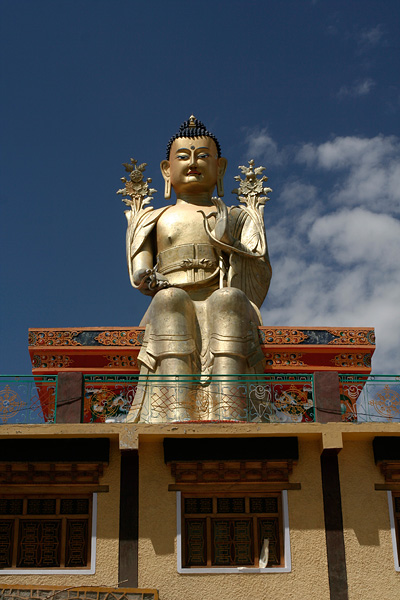
Buddha Statue at Likir Monastery
The contentment of Ladakh’s people is often attributed to their way of life and religious practices. Budhhism arrived in Ladakh more than a millennium ago when Tibetan rulers established their presence here, moulding the region’s cultural and religious practices. Having evolved with influences of Buddhist philosophy and Tibetan animist culture, it emerged as a system of complex rituals and iconography with multitude of gods, demigods and demons.
Most of Ladakh’s Buddhist population resides on the bank of Indus River, which flows from Tibet and sustains life in its fertile valley. Monasteries have thrived along the river for over a thousand years, serving as religious and learning centers of the region.
Nearly every village in Ladakh has a monastery of its own, which serves as the spiritual command for its inhabitants. These monasteries are often located on a hill overlooking the village. The villagers make donations to the monastery and receive spiritual services from the monks in return. Decades ago, every family would send one of their children to the monastery to become a monk. The practice, though in decline, still exists in many parts of Ladakh.
The small town of Leh is the administrative capital and transport hub of Ladakh, and is home to some of these ancient monasteries. Located on a hill overlooking the town is the small red structure of Namgyal Tsemo monastery built in 16th century. I made the strenuous walk up the hill and was quickly left tired, thanks to thin mountain air. But the efforts were rewarded by panoramic views of the green valley of Indus and the snow clad peaks of Zanskar ranges.
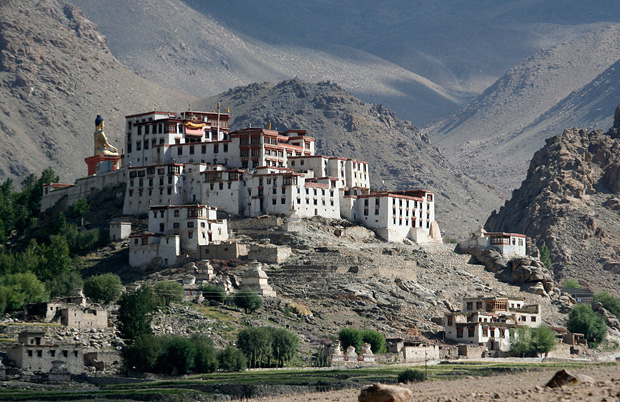
Likir Monastery
Downstream of Indus from Leh, the affluent monastery in Likir village is dominated by a 25 feet high statue of Buddha overlooking the mountains. Likir Monastery is a cluttered assembly of buildings surrounded by willow trees on a crag. A stream runs at the base of the crag, originating from the taller ice-capped mountains beyond the monastery.
I arrived at Likir on a day when the monks were performing a special worship to install Yamantaka Mandala. The Mandala is a circular structure with complex combination of colours within it, symbolizing the wisdom and compassion that form the pillars of Buddhist philosophy. Along with the Mandala, the prayer hall was decorated elaborately for the rituals with oil lamps and small motifs made of butter and barley flour.
Not far from Likir on the opposite bank of Indus is Alchi Village, where the eleventh century monastery is in the tentative list of UNESCO Wolrd Heritage Sites. Inner walls of the monastery are covered with colourful murals of a thousand Buddhas that have survived with age. Three-storey high statues of incarnations of Buddha adorn the center of these painted walls.
The paintings in Alchi vary considerably from other monasteries that are influenced by Tibetan culture and its animist origins. It doesn’t carry the extraordinary stylization and figures with demonic and unearthly features commonly seen on the walls of most other monasteries. On the contrary, they are said to bear resemblance to Buddhist paintings from the Indian plains, indicating that Alchi was perhaps built in a time when a wave of Buddhist preaching spread into Ladakh from Kashmir and North India. The monastery is also unique in having secular painting on the walls of the prayer hall, which include a sailing ship and the court of a king.
For reasons that puzzle historians, Alchi was abandoned as a place of worship many centuries ago and its structure was left unattended. Perhaps this abandonment helped in preserving the ancient paintings in the long run, as the monastery escaped the attention of marauding invaders from Kashmir as much as it escaped renovation and restoration efforts from the Ladakhi monks.
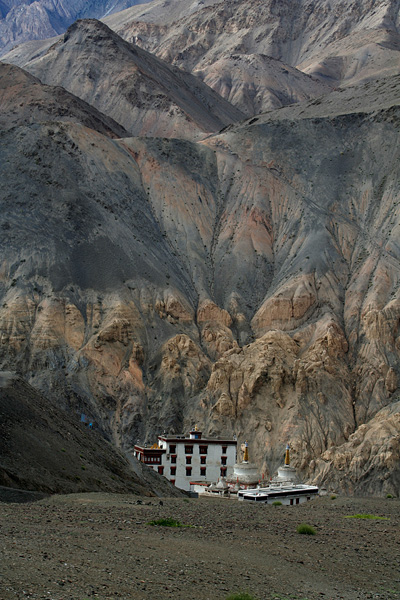
Lamayuru monastery hidden among lofty mountain slopes
Further down the Indus, the monastery at Lamayuru village is reached by driving past a steep ascent through switchback roads that can challenge the most experienced driver. My bus drivers sweats on the steering wheel as he goes back and forth, taking multiple attempts in clearing sharpest of the curves at the inclines. The road treads over the remains of a drained lake that has left curious formation of wrinkled slopes, often called as ‘moon land’. The monastery is built on a crag of mud that appears ready to collapse any time, but has lasted for more than eight centuries. Young monks learn here in a small monastic school and recite prayers in unison in a dimly lit prayer hall every morning.
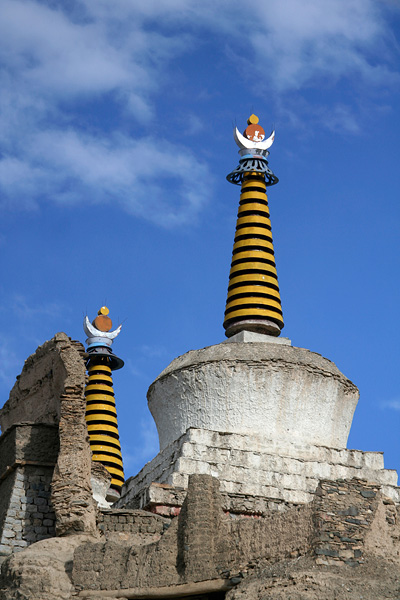
Chortens (stupa) at Lamayuru Monastery
While all these monasteries of Indus Valley are well connected by road and have some access to modern facilities, a different world unfolds in the remote Zanskar Region. Phugtal Monastery, deep in the valley of Zanskar, is so far away from everything that it takes two days of bus journey and another three days of walking just to get there. The monastery is located in a cave in the middle of a steep hill overlooking swift-flowing Lungnak River. Despite being in such a remote place that remains inaccessible and snowbound during the harsh winter months, the monks here were some of the happiest people I had ever seen. The elderly monks at the monastery had an affable and child-like smile that warmed me up the instant I looked at them.
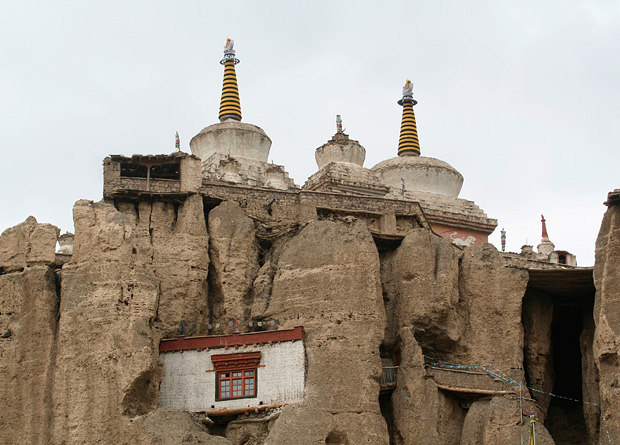
Chortens (stupa) at Lamayuru Monastery
These monasteries come alive during their annual festivals when the village gathers together to watch vibrant dances performed by monks wearing masks. The dance, called cham, is a ritual depicting exorcism. I watched a festive crowd gather for the annual celebration at Korzok Village bordering Tibet, where the usually ebullient Ladakhis appeared happier than ever. Women arrived at the monastery dressed with best traditional jewellery adorned with large turquoise stones.
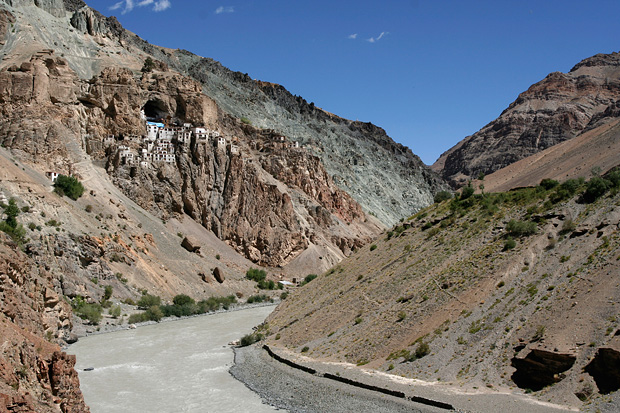
Phugtal Monastery, unbelievably perched precariously on a slope.
The cham dances are performed in an open quadrangle and is attended by a large gathering of people. Monks arrive one after other wearing demonic masks that have long canines and popping eyes. It begins with slow and easy moves of circling a flagpole and slowly gathers tempo, concluding with some quick moves that took me by surprise. The two day festival culminated in burning an effigy, symbolizing destruction of all evil that was accumulated through the year.
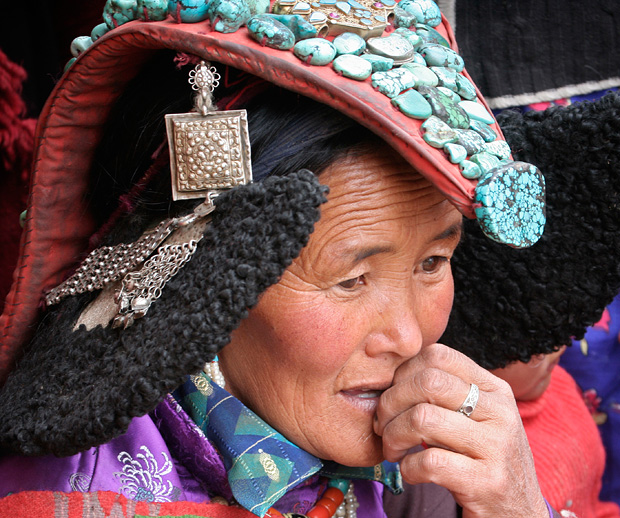
A traditionally attired Ladakhi woman at a festival in Korzok Monastery near Tso Moriri lake
Ladakh’s charm spreads beyond the ancient monasteries and extends into its beautiful landscape. While in Ladakh, I visited Pangong Lake that stretched more than 100km across two countries at an altitude of more 14,000 feet. I saw mountain ranges standing higher than 18,000 feet, where one can simply drive through. I went past more than 200 kilometres of arid and harsh landscape without seeing even single village.
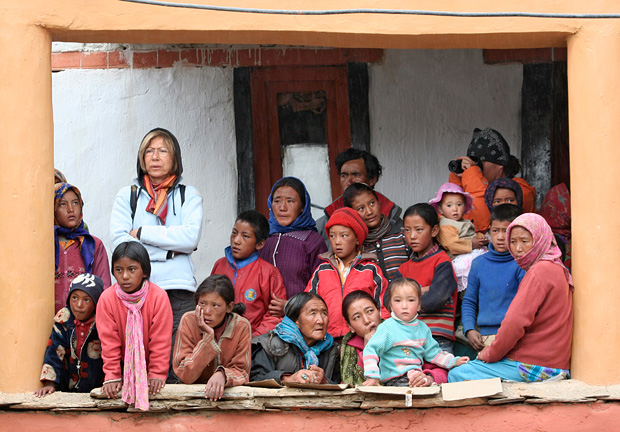
People watching cham dance performance at the festival in Korzok Monastery near Tso Moriri Lake
Looking for such landscapes of great scale in Ladakh, I ventured deeper into the mountains to the north of Leh, where the road climbed up steadily and slowly. The road winds up the slope to reach the mountain pass of Khardung La, claimed to be the highest motorable pass in the world. The views from here are unrestricted, with lines of snowy peaks decorating the skyline in all directions, and deep valley of Indus seen far below to the south.
Despite the hardship of life in this difficult terrain, the Ladakhis, like the monks at Phugtal, are a contented and friendly community who make visitors feel at home. The rich culture, high mountains and the smiling faces together make the experience of being here memorable.
+ Buy prints of these and other images of India Travel Blog






















